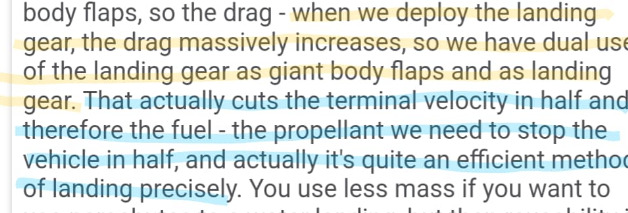You’ve already been provided several, Soyuz for example are used as air brakes almost exclusively.
The Falcon 9 booster uses all available surfaces for slowing down descent. This minimizes terminal velocity and reduces required propellant for landing. No, they don’t use all the propellant. This is intentional because as said above… You don’t want to run out of fuel when trying to land a multi-story tall building essentially.
Even the landing gear assist in reducing terminal velocity by 1/2.
The basic design of the grid fins as a control surface at high mach numbers would dictate thin grids to avoid wave drag. The falcon 9 seems optimized to increase drag and still flow at the same time unlike the R-77’s which is optimized simply for low drag.
Only you get to spout absurdities and then it’s hush so no one can correct you?
Even if you don’t believe me and want a source explicitly stating that it is used to assist slowing the falcon 9 down, you must admit it is absurd they’d make thick and draggy grid fins if heat was an issue… instead they manufactured even thicker titanium grid fins (the old ones were aluminum) instead of improving the heating issue by making the aluminum models thinner.
The tip of the R-77’s grids fins are ultra fine and pointy. It doesn’t matter how you scale a grid fin, if it isn’t being used to slow something down you’ll want the tips to be ultra sharp. This stalls the wave drag issue and reduces heating, improves airflow and control. The falcon has taken the opposite approach and uses peaks & valleys to ensure there is still flow while simultaneously allowing the high drag to minimize terminal velocity of the missile.
In their latest iterations, the landing gear isn’t even necessary in higher re-entry phases to slow the rocket down anymore.





